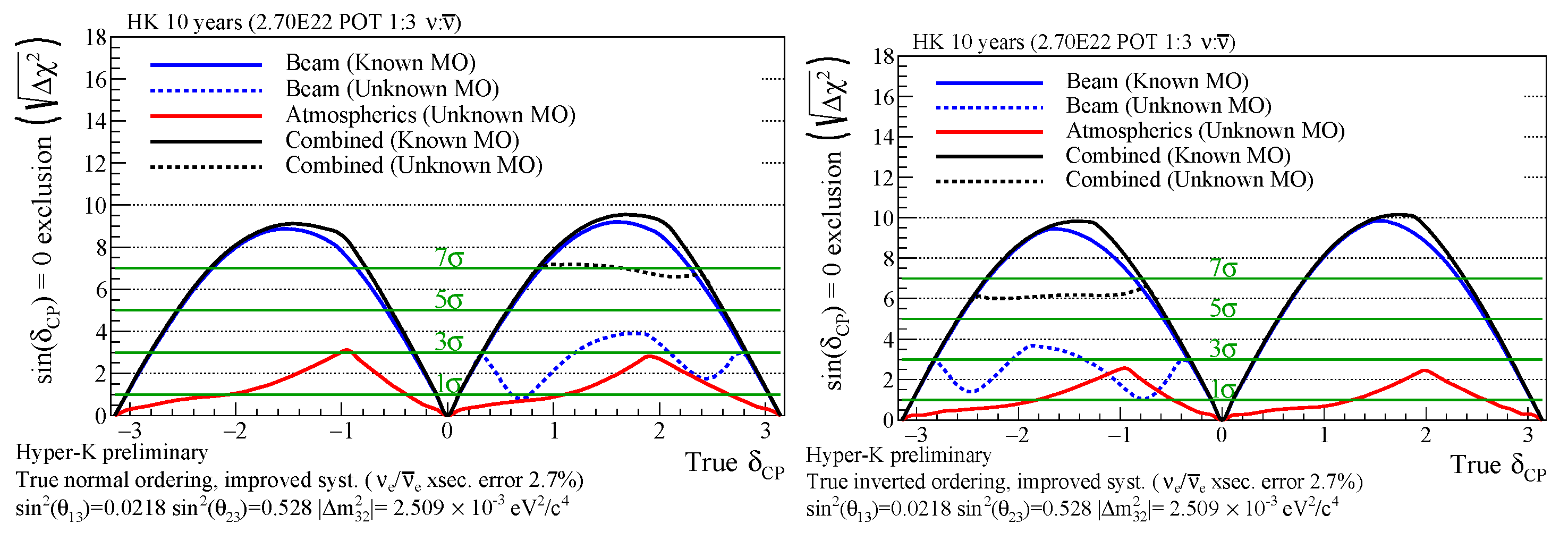Hyper-Kamiokande †
Abstract
:1. Introduction
2. Photomultiplier Tubes and In-Water Electronics
3. Neutrino Oscillations with the Neutrino Beam and Complementarity with DUNE and JUNO
4. Neutrino Oscillations with Atmospheric Neutrinos
5. Nucleon Decay
6. Neutrinos from Core-Collapse Supernovae
7. Solar Neutrinos
8. Summary
Funding
Institutional Review Board Statement
Informed Consent Statement
Data Availability Statement
Conflicts of Interest
References
- Abe, K.; Abe, K.; Aihara, H.; Aimi, A.; Akutsu, R.; Andreopoulos, C.; Anghel, I.; Anthony, L.H.V.; Antonova, M.; Ashida, Y.; et al. Hyper-Kamiokande Design Report. arXiv 2018, arXiv:1805.04163. [Google Scholar]
- Hirata, K.S.; Kajita, T.; Kifune, T.; Kihara, K.; Nakahata, M.; Nakamura, K.; Ohara, S.; Oyama, Y.; Sato, N.; Takita, M.; et al. Observation of b 8 solar neutrinos in the kamiokande-ii detector. Phys. Rev. Lett. 1989, 63, 16. [Google Scholar] [CrossRef] [PubMed]
- Bronner, C.; Nishimura, Y.; Xia, J.; Tashiro, T. Development and performance of the 20″ PMT for Hyper-Kamiokande. J. Phys. Conf. Ser. 2020, 1468, 012237. [Google Scholar] [CrossRef]
- Agarwalla, S.; Das, S.; Giarnetti, A.; Meloni, D.; Singh, M. Enhancing Sensitivity to Leptonic CP Violation using Complementarity among DUNE, T2HK, and T2HKK. arXiv 2022, arXiv:2211.10620. [Google Scholar] [CrossRef]
- Abe, K.; Haga, Y.; Hayato, Y.; Ikeda, M.; Iyogi, K.; Kameda, J.; Kishimoto, Y.; Miura, M.; Moriyama, S.; Nakahata, M.; et al. Limits on sterile neutrino mixing using atmospheric neutrinos in Super-Kamiokande. Phys. Rev. D 2015, 91, 052003. [Google Scholar] [CrossRef]
- Mitsuka, G.; Abe, K.; Hayato, Y.; Iida, T.; Ikeda, M.; Kameda, J.; Koshio, Y.; Miura, M.; Moriyama, S.; Nakahata, M.; et al. Study of nonstandard neutrino interactions with atmospheric neutrino data in Super-Kamiokande I and II. Phys. Rev. D 2011, 84, 113008. [Google Scholar] [CrossRef]
- Abe, K.; Adrich, P.; Aihara, H.; Akutsu, R.; Alekseev, I.; Ali, A.; Ameli, F.; Anghel, I.; Anthony, L.H.V.; Antonova, M.; et al. Supernova model discrimination with Hyper-Kamiokande. ApJ 2021, 916, 15. [Google Scholar] [CrossRef]
- Bays, K.; Iida, T.; Abe, K.; Hayato, Y.; Iyogi, K.; Kameda, J.; Koshio, Y.; Marti, L.; Miura, M.; Moriyama, S.; et al. Supernova relic neutrino search at Super-Kamiokande. Phys. Rev. D 2012, 85, 052007. [Google Scholar] [CrossRef]
- Locke, S.; Coffani, A.; Abe, K.; Bronner, C.; Hayato, Y.; Ikeda, M.; Imaizumi, S.; Ito, H.; Kameda, J.; Kataoka, Y.; et al. New methods and simulations for cosmogenic induced spallation removal in Super-Kamiokande-IV. arXiv 2021, arXiv:2112.00092. [Google Scholar]
- Wolfenstein, L. Neutrino oscillations in matter. Phys. Rev. D 1978, 17, 2369. [Google Scholar] [CrossRef]
- Mikheyev, S.P.; Smirnov, A.Y. Resonance Amplification of Oscillations in Matter and Spectroscopy of Solar Neutrinos. Sov. J. Nucl. Phys. 1985, 42, 913. [Google Scholar]
- Smy, M.B.; Ashie, Y.; Fukuda, S.; Fukuda, Y.; Ishihara, K.; Itow, Y.; Koshio, Y.; Minamino, A.; Miura, M.; Moriyama, S.; et al. Precise measurement of the solar neutrino day-night and seasonal variation in Super-Kamiokande-I. Phys. Rev. D 2004, 69, 011104. [Google Scholar] [CrossRef]







Disclaimer/Publisher’s Note: The statements, opinions and data contained in all publications are solely those of the individual author(s) and contributor(s) and not of MDPI and/or the editor(s). MDPI and/or the editor(s) disclaim responsibility for any injury to people or property resulting from any ideas, methods, instructions or products referred to in the content. |
© 2023 by the author. Licensee MDPI, Basel, Switzerland. This article is an open access article distributed under the terms and conditions of the Creative Commons Attribution (CC BY) license (https://creativecommons.org/licenses/by/4.0/).
Share and Cite
Smy, M.B., on behalf of the Hyper-Kamiokande Collaboration. Hyper-Kamiokande. Phys. Sci. Forum 2023, 8, 41. https://doi.org/10.3390/psf2023008041
Smy MB on behalf of the Hyper-Kamiokande Collaboration. Hyper-Kamiokande. Physical Sciences Forum. 2023; 8(1):41. https://doi.org/10.3390/psf2023008041
Chicago/Turabian StyleSmy, Michael B. on behalf of the Hyper-Kamiokande Collaboration. 2023. "Hyper-Kamiokande" Physical Sciences Forum 8, no. 1: 41. https://doi.org/10.3390/psf2023008041
APA StyleSmy, M. B., on behalf of the Hyper-Kamiokande Collaboration. (2023). Hyper-Kamiokande. Physical Sciences Forum, 8(1), 41. https://doi.org/10.3390/psf2023008041




